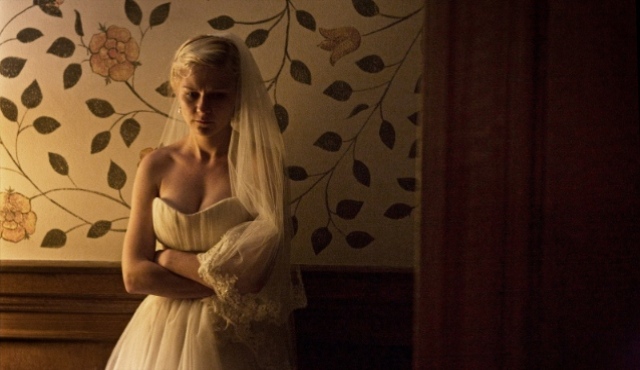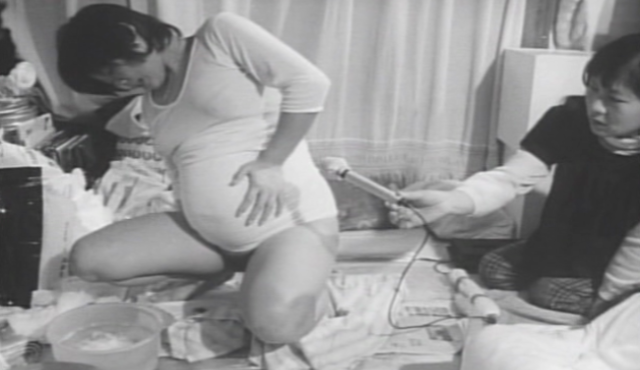
“In its earliest uses unhappy meant to cause misfortune or trouble.”
-Sara Ahmed, The Promise of Happiness
Melancholia (2011) is the story of two sisters and their family who, like the rest of humanity, must face the end of the world as the planet Melancholia hurls toward Earth. Comprised of two parts named for the siblings, “Justine” (played by Kirsten Dunst) and “Claire” (played by Charlotte Gainsbourg), the film begins with a serene digital vision of the apocalypse: a planet collides with Earth. But this is not the typical Hollywood doomsday scenario. The overture’s detailed imagery and lush cinematography bespeak more beauty than doom—or at least are suggestive of the possibility that the two are not mutually exclusive. Thus director Lars von Trier offers a refreshing counterpoint to the traditional cinematic apocalypse, a narrative that usually hinges on a masculine exceptionalism. By inverting the doomsday discourse—and by pushing against bourgeois sentimentalism—von Trier’s film opens out onto new possibilities for conceiving subjectivity, specifically female subjectivity, in this new digital world.
Melancholia picks up just past the point where most fairytales end: a sumptuous wedding reception in a grand castle. Yet this is no “happily ever after” celebration. From the outset, it becomes painfully obvious that something is “wrong” with our bride. Justine is hours late for her own reception, and when she arrives at the castle doors, Claire stops her with a guilt-inducing question: “Okay, so you want this?” John (Kiefer Sutherland), Justine’s wealthy brother-in-law, further reminds the bride they have hired “the most expensive wedding planner on the planet.” Yet Justine still insists on visiting her favourite horse in the stables and tucking her nephew into bed, and when she finally arrives at the party, she swigs from a bottle of booze while dancing. Claire’s chastising and John’s passive-aggressive haranguing speak to the role Justine is expected to play as “the bride,” both a gendered and commodified construct within the ritual of the “enchanted wedding.” Justine, however, rebuffs the fantastical bridal image and refuses the disciplining rhetoric of the wedding industry. It is no small act; the wedding planner (Udo Kier) refuses to look at her, holding a hand to his face to block his gaze as she passes. Kier’s character embodies the billion-dollar industry Justine is turning her back on, his gesture not only symbolic of his own repulsion at her behaviour, but the disdain of society at large.
Indeed, the closer the planet gets to Earth, the less beholden Justine seems to traditional forms of femininity; the planet is not only ushering the end of the physical world, but the societal constructs that govern lived experience. We see this at the breakfast table when Justine speaks openly about herself for the first time, suggesting that she is clairvoyant, licking jam off of her fingers, and unabashedly telling her sister what she really thinks about the apocalypse: “The Earth is evil. No one will miss it.” Justine is what feminist theorist Sara Ahmed would call an affect alien. By not following the happiness narrative of the wedding day, the obvious fissure between what she is expected to feel and what she does feel makes everyone at the reception uncomfortable. As such, Justine and her story fit well into a long history of feminist work in which everyday objects of domesticity become menacing.
Although Justine initially fits the image of the blushing bride—ornate white dress, well-coiffed hair—she soon comes undone. Through the erosion of Justine’s pristine bridal image, we are offered an alternative portrayal of the idealized bride popularized by countless print publications, from Martha Stewart Wedding to White (a title that unintentionally nods to the racialized world portrayed in its pages). These glossy mags suggest that the bride exercises her empowerment by purchasing the correct tasteful and stylish items meant to signify her character and contribute to the perfect wedding—clearly coded as the beginning of long-lasting marital bliss. Von Trier’s footage of the wedding reception eschews the wistful, dreamy bridal fantasy. His shaky, hand-held camera seemingly roves without motivation, creating a dislocating and jarring experience rather than capturing staged portraits of perfection, while harsh light ruptures the blissful wedding setting. It is clear von Trier is mocking bourgeois cultural myths like the one circulated through these types of publications, as well as the idea of the “pro-feminist” consumer buying into a perfect wedding to secure a perfect marriage. This idea is literally pissed on when Justine eventually escapes the increasingly claustrophobic party to urinate on the golf greens in her cumbersome white gown.
While many critics pathologize Justine, reading her as a victim of serious clinical depression, I believe that it is far more generative for feminist critics to locate Justine within contemporary techno-feminist discourses, a group of feminist philosophies that emerged in the nineties and sought to exploit cyberspace, the internet, and new media technologies. In doing so, one can recognize the agency inherent to Justine’s character, and the end of this world becomes liberating. The juxtaposition of CGI and video game aesthetics with the “high art” imagery of German Romanticism constructs a powerful female subject whose identity is created both within the diegesis (through a nuanced negotiation of traditional femininity), and within imagery from faux-couture photoshoots. High-fashion bridal wear is re-inscribed through the innovative use of digital effects technology with alternative meanings, as in the dream sequence during which Justine trudges through the gardens in her wedding gown while being held back by thick, grey vines. The moment when Justine is pulled downstream in her wedding garments exemplifies von Trier’s employment of current technologies to animate antiquated and often gendered visual archetypes. As Justine floats in the water, her stare is fixed on the sky/camera in a version of the nineteenth-century painting of Shakespeare’s Ophelia by John Everett Millais.
By appropriating Millais’ painting while simultaneously resisting Ophelia’s glee and hysteria, von Trier offers a powerful corrective to the existing archetype of female (un)happiness. This beautiful image operates in resistance to historic accounts of angry, “crazy” women, honoring Justine’s unhappiness and aggression by locating her emotions within a historical context and placing her in an erotic economy that operates outside the patriarchal legal institution of marriage. In three distinct instances, von Trier portrays Justine’s body and sexuality as her own—as subject rather than object. After the collective mood of celebration abates at the reception, Justine spontaneously mounts a stranger on the manicured lawn in her wedding dress. Later, Claire lifts her sister into the bathtub, and though Justine is naked, her form is neither hidden nor hyper-eroticized. Later, when Justine basks on a riverbank at night—nude, arms outstretched, her alabaster skin shimmering in the light cast down upon the Earth by the planet Melancholia—she strikes a pose very similar to those of nymphs and fairies in classical Renaissance iconography. However, Justine is not simply coded within the framework of to-be-looked-at-ness, but is rather casting a gaze upward and revelling in her acceptance of impending doom.
Justine’s inability—or alternatively, refusal—to enjoy the “happiest day of her life” can be read as both an assault on traditional femininity and a political act. The gendered politics of depression and happiness play out through von Trier’s staging of human sociality through empty ritual and then meaningful chaos. Justine’s consciousness is arguably a feminist one, reflected in the fact that “failure” to be folded into the structure of feeling created by the lavish wedding reception is embedded in von Trier’s cinematic style. Her emotions, coded into the film’s images, play on the various gendered meanings that have circulated through and across the genealogy and imagery of happiness in Western art.
One lasting ambiguity in the plot rests in the liminal space occupied by Justine after the end of the Earth. After Melancholia strikes our planet, the opening frames that emerge from the darkness feature an extreme close-up of Justine’s face: haggard and tired, with dead birds falling and spiralling around her. This use of an extreme close-up is punctuated with graphics reminiscent of an elaborate cutscene from a video game. Each preceding shot in the overture maps out the events of the narrative. The image of Justine’s face is suggestive of the new world-making possibilities that von Trier gestures toward through his female protagonist. The temporal status of this shot is unfixed in an otherwise linear plot. This moment signifies an “in-between” space, and evokes within this dreamlike sequence the various colliding claims to epistemological truths that Melancholia negotiates, finally opening a space for an affirmative female identity. Nobody can make Justine “happy,” but von Trier sends her out into the ether at the end of the world through digital imagery suggesting that she may yet discover the jouissance that lay in wait for her.




